Thermodynamic Optimization of Aircraft Environmental Control System Using Modified Genetic Algorithm
Abstract
:1. Introduction
2. Materials and Methods
2.1. Component-Level Model and Verification
2.2. Thermo-Economics Criterion
2.3. Design Parameters and Optimization Variables
2.4. Modified Optimization Method
3. Results and Discussions
3.1. Comparison with Standard GA
3.2. Analysis of the Optimized ECS
4. Conclusions
Author Contributions
Funding
Institutional Review Board Statement
Informed Consent Statement
Data Availability Statement
Conflicts of Interest
Nomenclature
| ECS | environment control system | v | average velocity [m·s−1] |
| DOF | degree of freedom | W | power [kW] |
| GA | genetic algorithm | ||
| a | lower bound of variable | ||
| A1 | heat transfer area of primary heat exchanger [m2] | Greek abbreviation | |
| A2 | heat transfer area of secondary heat exchanger [m2] | β | the ratio of weight to heat transfer area [kg· m−2] |
| AHX | heat transfer area [m2] | η | efficiency |
| b | upper bound of variable | κ | adiabatic index of air |
| cp | specific heat at constant pressure [J·kg−1·K] | λ | resistance coefficient |
| C | constant | μ | ratio of heat capacity rates (NTU method) |
| D | pipeline diameter [m] | μa | dynamic viscosity of air [N·s·m−2] |
| DE | extra drag [N] | π | pressure ratio |
| E | energy consumption [kW] | ρ | density [kg/m3] |
| EProp | energy consumption for resistance [kW] | τ | temperature ratio |
| EShaft | energy consumption in core engine shaft [kW] | ||
| EHX,m | energy consumption caused by extra weight [kW] | Subscripts | |
| FECR | fuel energy consumption rate [kW] | bleed | bleed air |
| Fit | fitness function | c | compressor |
| g | gravitational acceleration [m·s−2] | cold | cold side of heat exchanger |
| G | bit code of gene | d | diffuser |
| h | specific enthalpy [W·m−2·K−1] | ex | exhaust |
| K | lift-drag ratio | f | fan |
| L | length of the pipeline [m] | hot | hot side of heat exchanger |
| m | mass flow rate [kg·s−1] | HX | heat exchanger |
| mHX | weight of the heat exchanger [kg] | in | inlet |
| Ma | Mach number | m | mutation |
| NTU | number of transfer units | n | nozzle |
| p | pressure [kPa] | out | outlet |
| P | probability | p | propulsive |
| Qcool | cooling capacity [kW] | ram | ram air |
| R | air constant [J·mol−1·K−1] | t | turbine |
| Re | Reynolds number, =ρvd/μa | th | thermal |
| T | temperature [K] | ||
| T0 | ambient total temperature [K] | ||
| T0,s | ambient static temperature [K] | ||
References
- Fawal, S.; Kodal, A. Comparative performance analysis of various optimization functions for an irreversible Brayton cycle applicable to turbojet engines. Energy Convers. Manag. 2019, 199, 111976.1–111976.13. [Google Scholar] [CrossRef]
- Tuzcu, H.; Sohret, Y.; Caliskan, H. Energy, environment and enviroeconomic analyses and assessments of the turbofan engine used in aviation industry. Environ. Prog. Sustain. Energy 2021, 40, e13547. [Google Scholar] [CrossRef]
- Aygun, H.; Turan, O. Exergetic sustainability off-design analysis of variable-cycle aero-engine in various bypass modes. Energy 2020, 195, 117008. [Google Scholar] [CrossRef]
- Dechow, M.; Nurcombe, C. Aircraft environmental control systems. In Air Quality in Airplane Cabins and Similar Enclosed Spaces; Springer: Berlin/Heidelberg, Germany, 2005. [Google Scholar]
- Linnett, K.; Crabtree, R. What’s next in commercial aircraft environmental control systems? SAE Trans. 1993, 102, 639–653. [Google Scholar]
- He, H.; Hao, J. Optimum design for environmental control system of aircraft cabin. J. Beijing Univ. Aeronaut. Astronaut. 1996, 5, 55–61. [Google Scholar]
- Hong, W.; Wang, J. Aircraft ECS reliability design and evaluation. Acta Aeronaut. ET Astronaut. Sin. 1998, 02, 97–100. [Google Scholar]
- Ma, J.; Chen, L.; Liu, H. Fault diagnosis for the heat exchanger of the aircraft environmental control system based on the strong tracking filter. PLoS ONE 2015, 10, e0122829. [Google Scholar] [CrossRef]
- Li, H.B.; Dong, X.M.; Guo, J.; Chen, Y.; Li, T.T. Heat exchanger optimization analysis of aircraft environmental control system. Adv. Mater. Res. 2011, 383–390, 5536–5541. [Google Scholar] [CrossRef]
- Vargas, J.V.C.; Bejan, A. Thermodynamic optimization of finned crossflow heat exchangers for aircraft environmental control systems. Int. J. Heat Fluid Flow 2001, 22, 657–665. [Google Scholar] [CrossRef]
- Alebrahim, A.; Bejan, A. Thermodynamic optimization of heat-transfer equipment configuration in an environmental control system. Int. J. Energy Res. 2001, 25, 1127–1150. [Google Scholar] [CrossRef]
- Ordonez, J.C.; Bejan, A. Minimum power requirement for environmental control of aircraft. Energy 2003, 28, 1183–1202. [Google Scholar] [CrossRef]
- Pérez-Grande, I.; Leo, T.J. Optimization of a commercial aircraft environmental control system. Appl. Therm. Eng. 2002, 22, 1885–1904. [Google Scholar] [CrossRef]
- Vargas, J.; Bejan, A. Integrative thermodynamic optimization of the environmental control system of an aircraft. Int. J. Heat Mass Transf. 2001, 44, 3907–3917. [Google Scholar] [CrossRef]
- Yoo, Y.J.; Lee, H.J.; Kho, S.H.; Ki, J.Y. A study on modeling program development of an environmental control system. J. Korean Soc. Propuls. Eng. 2009, 13, 57–63. [Google Scholar]
- Bello-Ochende, T.; Simasiku, E.; Baloyi, J. Optimum design of heat exchanger for environmental control system of an aircraft using entropy generation minimization (EGM) technique. In Proceedings of the 12th International Conference on Heat Transfer, Fluid Mechanics and Thermodynamics, Malaga, Spain, 11–13 July 2016. [Google Scholar]
- Tipton, R.; Figliola, R.S.; Ochterbeck, J.M. Thermal optimization of the ECS on an advanced aircraft with an emphasis on system efficiency and design methodology. In Proceedings of the SAE Aerospace Power Systems Conference & Exposition, Warrendale, PA, USA, 4 April 1997; SAE International: Warrendale, PA, USA, 1997. [Google Scholar]
- Figliola, R.S.; Tipton, R.; Li, H. Exergy approach to decision-based design of integrated aircraft thermal systems: Exergy. J. Aircr. 2003, 40, 49–55. [Google Scholar] [CrossRef]
- Zhao, H.; Yu, H.; Zhu, Y.; Chen, L.; Chen, S. Experimental study on the performance of an aircraft environmental control system. Appl. Therm. Eng. 2009, 29, 3284–3288. [Google Scholar] [CrossRef]
- Li, X.; Chen, Q.; Hao, J.-H.; Chen, X.; He, K.-L. Heat current method for analysis and optimization of a refrigeration system for aircraft environmental control system. Int. J. Refrig. 2019, 106, 163–180. [Google Scholar] [CrossRef]
- Cui, G.W. The Research on Optimization Method of Aircraft Environment Control System. Master’s Thesis, Nanjing University of Aeronautics and Astronautics, Nanjing, China, December 2010. [Google Scholar]
- Tu, Y.; Lin, G.P. Dynamic simulation of aircraft environmental control system based on flowmaster. J. Aircr. 2011, 48, 2031–2041. [Google Scholar] [CrossRef]
- Bejan, A.; David, L.S. The need for exergy analysis and thermodynamic optimization in aircraft development. Exergy Int. J. 2001, 1, 14–24. [Google Scholar] [CrossRef]
- Hou, X.D. The Simulation and Research of Aircraft Environment Control System. Master’s Thesis, Nanjing University of Aeronautics and Astronautics, Nanjing, China, December 2010. [Google Scholar]
- Jiang, H.; Dong, S.; Zhang, H. Energy efficiency analysis of electric and conventional environmental control system on commercial aircraft. In Proceedings of the 2016 IEEE/CSAA International Conference on Aircraft Utility Systems(AUS), Beijing, China, 10–12 October 2016. [Google Scholar]
- Yang, Y.; Gao, Z. Power optimization of the environmental control system for the civil more electric aircraft. Energy 2019, 172, 196–206. [Google Scholar] [CrossRef]
- Dai, Y.; Wang, J.; Lin, G. Exergy analysis, parametric analysis and optimization for a novel combined power and ejector refrigeration cycle. Appl. Therm. Eng. 2009, 29, 1983–1990. [Google Scholar] [CrossRef]
- Zhang, S.; Wang, H.; Tao, G. Performance comparison and parametric optimization of subcritical organic rankine cycle (ORC) and transcritical power cycle system for low-temperature geothermal power generation. Appl. Energy 2011, 88, 2740–2754. [Google Scholar]
- Perera, A.; Attalage, R.A.; Perera, K.; Dassanayake, V. A hybrid tool to combine multi-objective optimization and multi-criterion decision making in designing standalone hybrid energy systems. Appl. Energy 2013, 107, 412–425. [Google Scholar] [CrossRef]
- Shiba, T.; Bejan, A. Thermodynamic optimization of geometric structure in the counterflow heat exchanger for an environmental control system. Energy 2001, 26, 493–512. [Google Scholar] [CrossRef]
- Sanaye, S.; Hajabdollahi, H. Thermal-economic multi-objective optimization of plate fin heat exchanger using genetic algorithm. Appl. Energy 2010, 87, 1893–1902. [Google Scholar] [CrossRef]
- Bejan, A. A role for exergy analysis and optimization in aircraft energy-system design. In Proceedings of the ASME International Mechanical Engineering Congress and Exposition, Nashville, TN, USA, 14–19 November 1999. [Google Scholar]
- Mishra, M.; Das, P.K.; Sarangi, S. Second law based optimisation of crossflow plate-fin heat exchanger design using genetic algorithm. Appl. Therm. Eng. 2009, 29, 2983–2989. [Google Scholar] [CrossRef] [Green Version]
- Patel, V.; Rao, R. Design optimization of shell-and-tube heat exchanger using particle swarm optimization technique. Appl. Therm. Eng. 2010, 30, 1417–1425. [Google Scholar] [CrossRef]
- West, A.; Sherif, S. Optimization of multistage vapour compression systems using genetic algorithms. Part 1: Vapour compression system model. Int. J. Energy Res. 2001, 25, 803–812. [Google Scholar] [CrossRef]
- Mo, Z.J.; Zhu, X.J.; Wei, L.Y.; Cao, G.Y. Parameter optimization for a pemfc model with a hybrid genetic algorithm. Int. J. Energy Res. 2006, 30, 585–597. [Google Scholar] [CrossRef]
- Avval, H.B.; Ahmadi, P.; Ghaffarizadeh, A.R.; Saidi, M.H. Thermo-economic-environmental multiobjective optimization of a gas turbine power plant with preheater using evolutionary algorithm. Int. J. Energy Res. 2011, 35, 389–403. [Google Scholar] [CrossRef]
- Özçelik, Y. Exergetic optimization of shell and tube heat exchangers using a genetic based algorithm. Appl. Therm. Eng. 2007, 27, 1849–1856. [Google Scholar] [CrossRef]
- Valdevit, L.; Pantano, A.; Stone, H.A.; Evans, A.G. Optimal active cooling performance of metallic sandwich panels with prismatic cores. Int. J. Heat Mass Transf. 2006, 49, 3819–3830. [Google Scholar] [CrossRef]
- Guan, B.; Zhang, C.; Ning, J. Genetic algorithm with a crossover elitist preservation mechanism for protein–ligand docking. Amb Express 2017, 7, 174. [Google Scholar] [CrossRef] [PubMed] [Green Version]
- Peng, H.; Ling, X. Optimal design approach for the plate-fin heat exchangers using neural networks cooperated with genetic algorithms. Appl. Therm. Eng. 2008, 28, 642–650. [Google Scholar] [CrossRef]
- Maser, A.; Garcia, E.; Mavris, D. Characterization of thermodynamic irreversibility for integrated propulsion and thermal management systems design. In Proceedings of the 50th AIAA Aerospace Sciences Meeting including the New Horizons Forum and Aerospace Exposition, Nashville, TN, USA, 9–12 January 2012; p. 1124. [Google Scholar]
- “Type-Certificate Data Sheet RB211 Trent 700 Series Engines” (PDF). EASA. 14 October 2014. Archived from the Original (PDF) on 16 August 2016. Retrieved 1 July 2017. Available online: https://www.easa.europa.eu/document-library/type-certificates/engine-cs-e/easae042-rolls-royce-deutschland-rb211-trent-700 (accessed on 14 March 2022).
- Guo, J.; Cheng, L.; Xu, M. Optimization design of shell-and-tube heat exchanger by entropy generation minimization and genetic algorithm. Appl. Therm. Eng. 2009, 29, 2954–2960. [Google Scholar] [CrossRef]



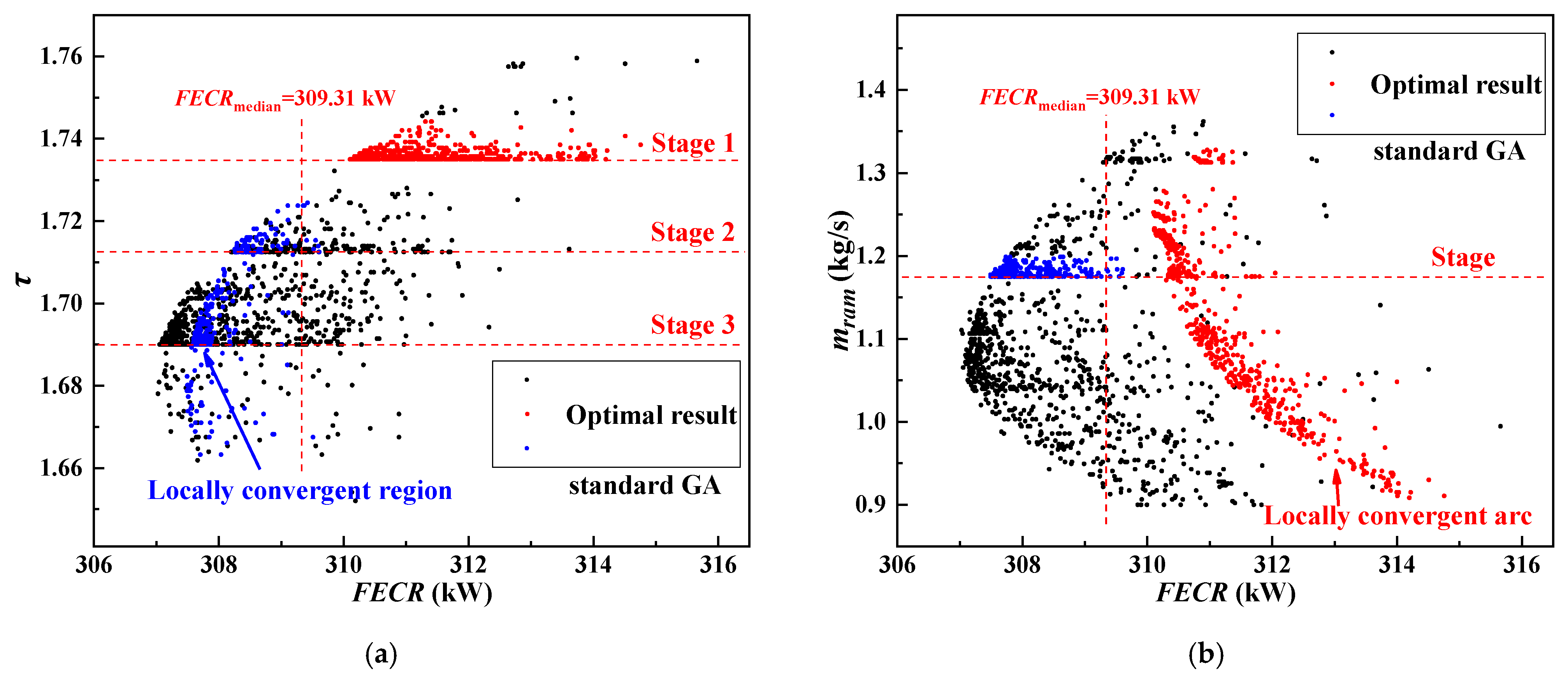
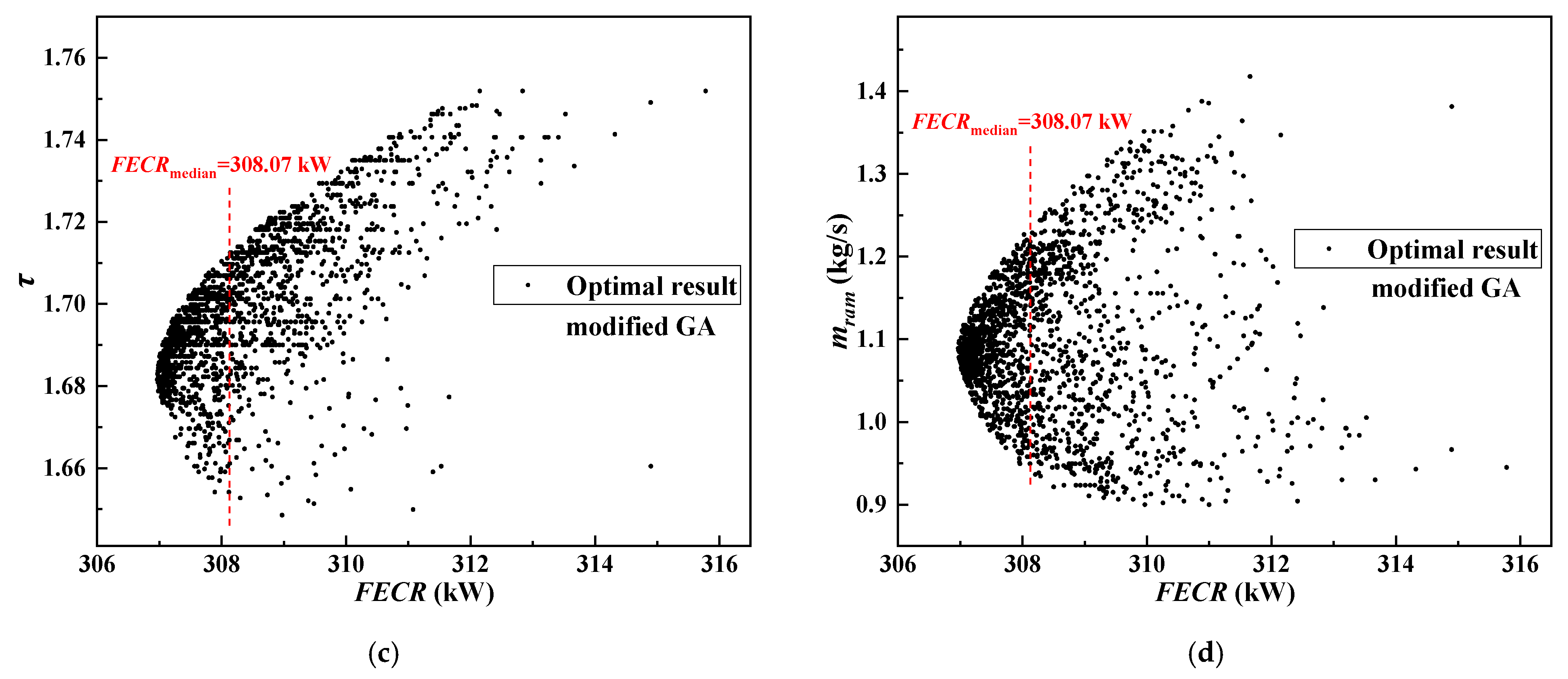

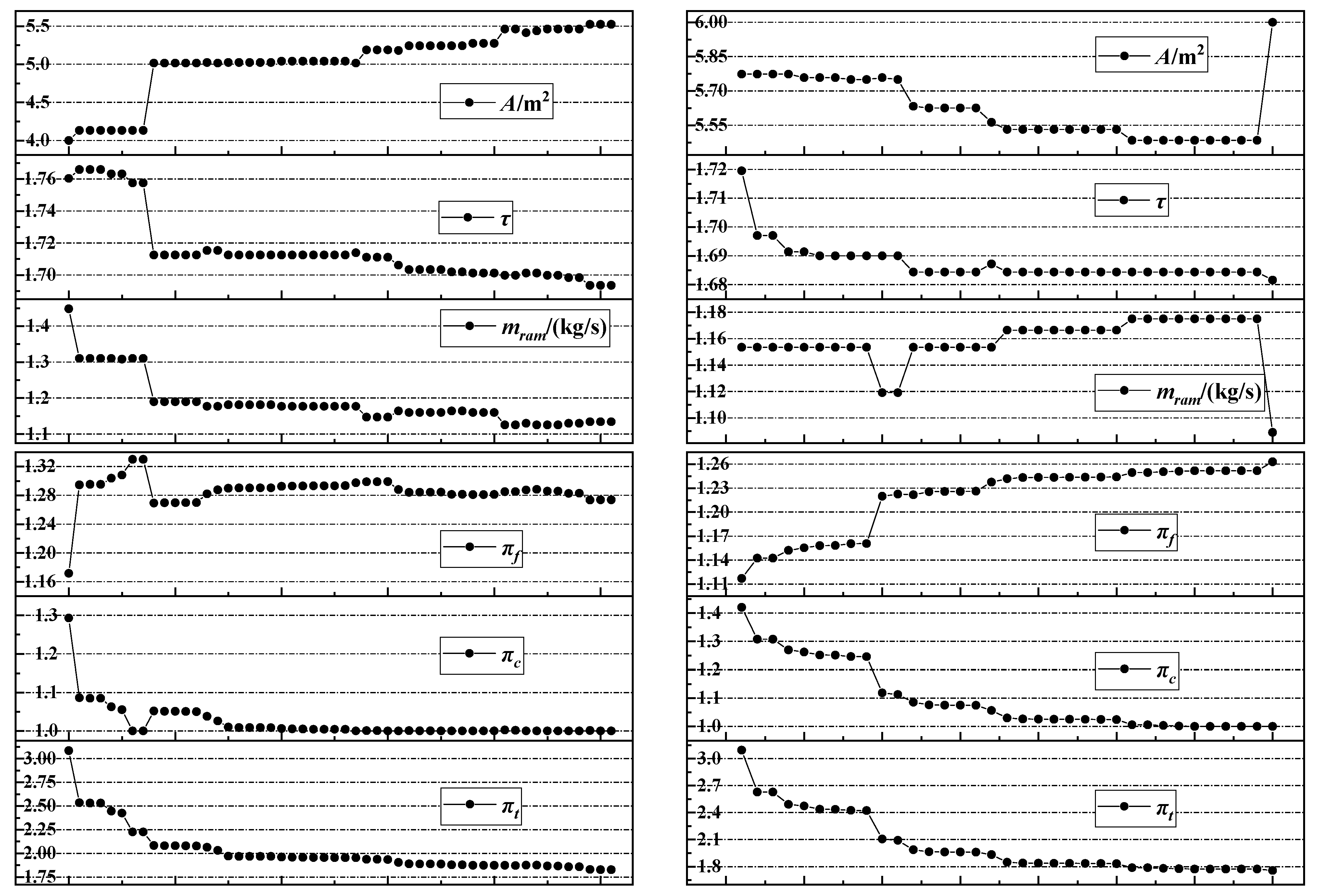

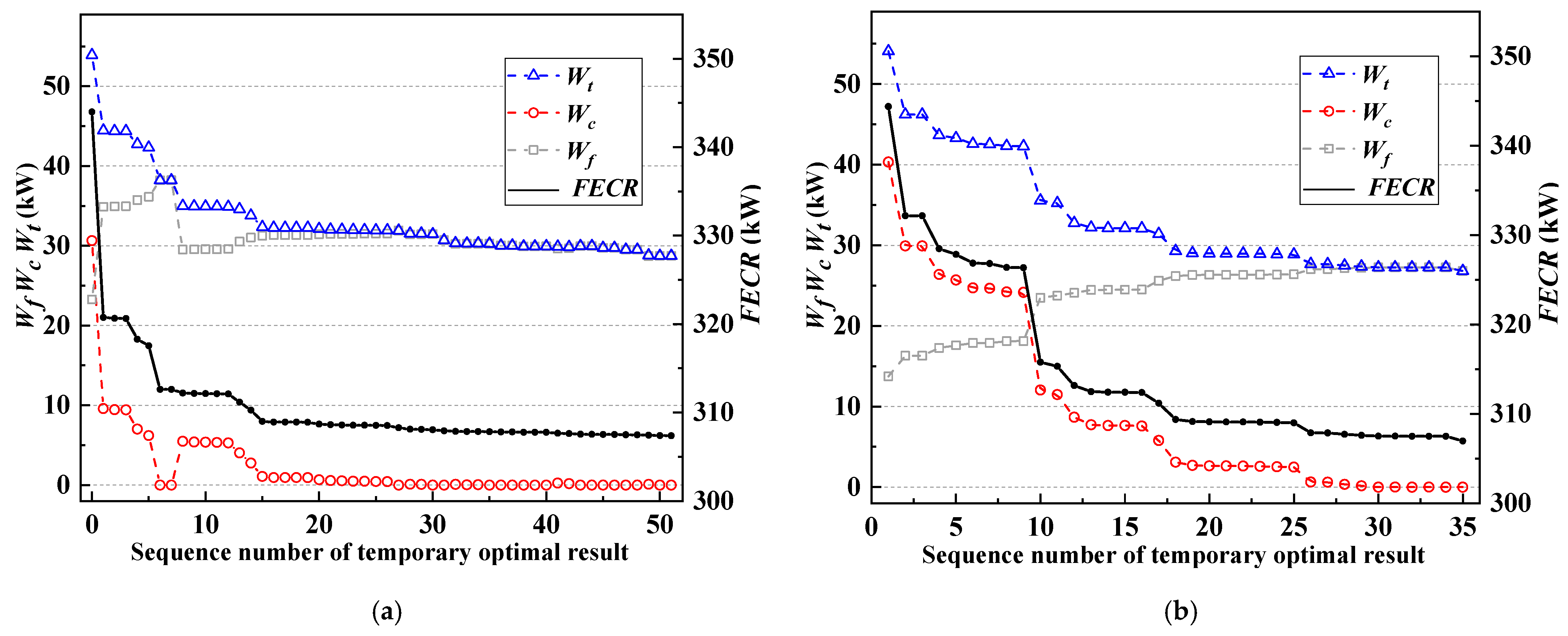
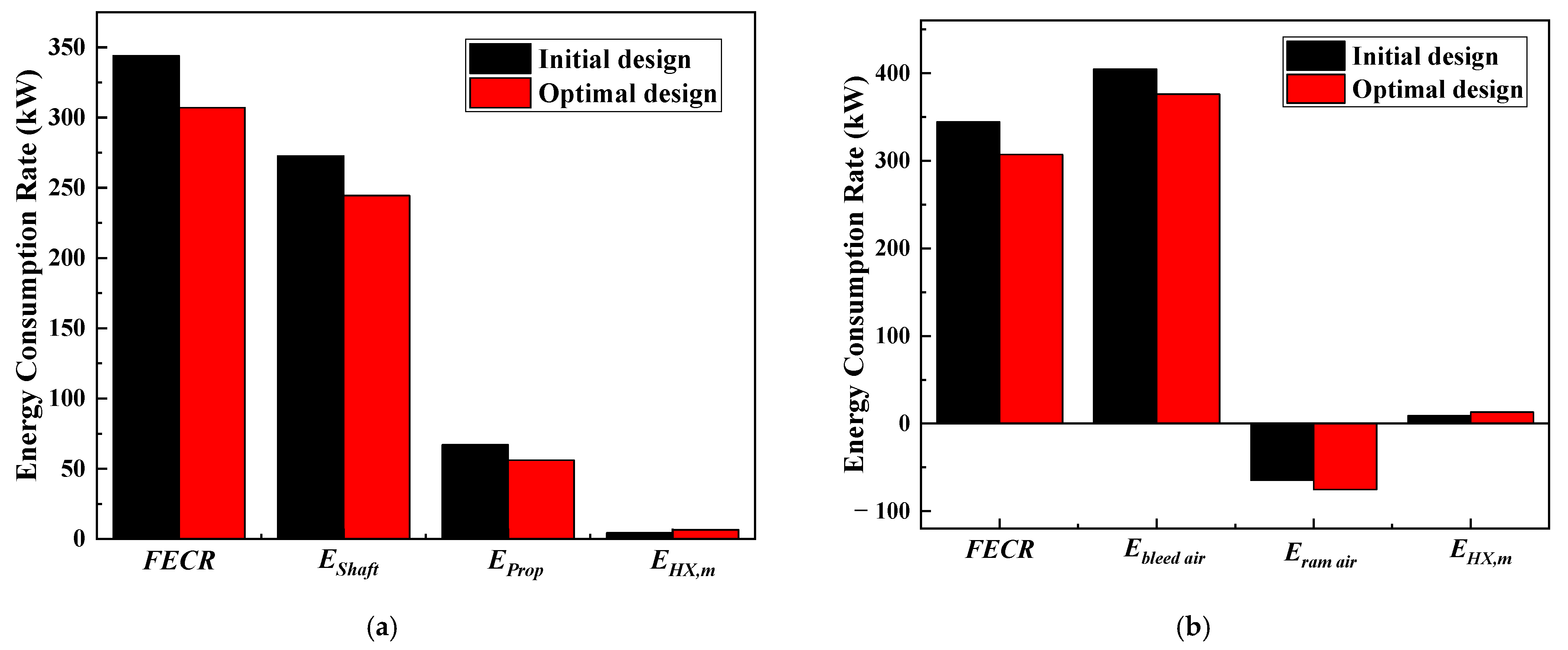
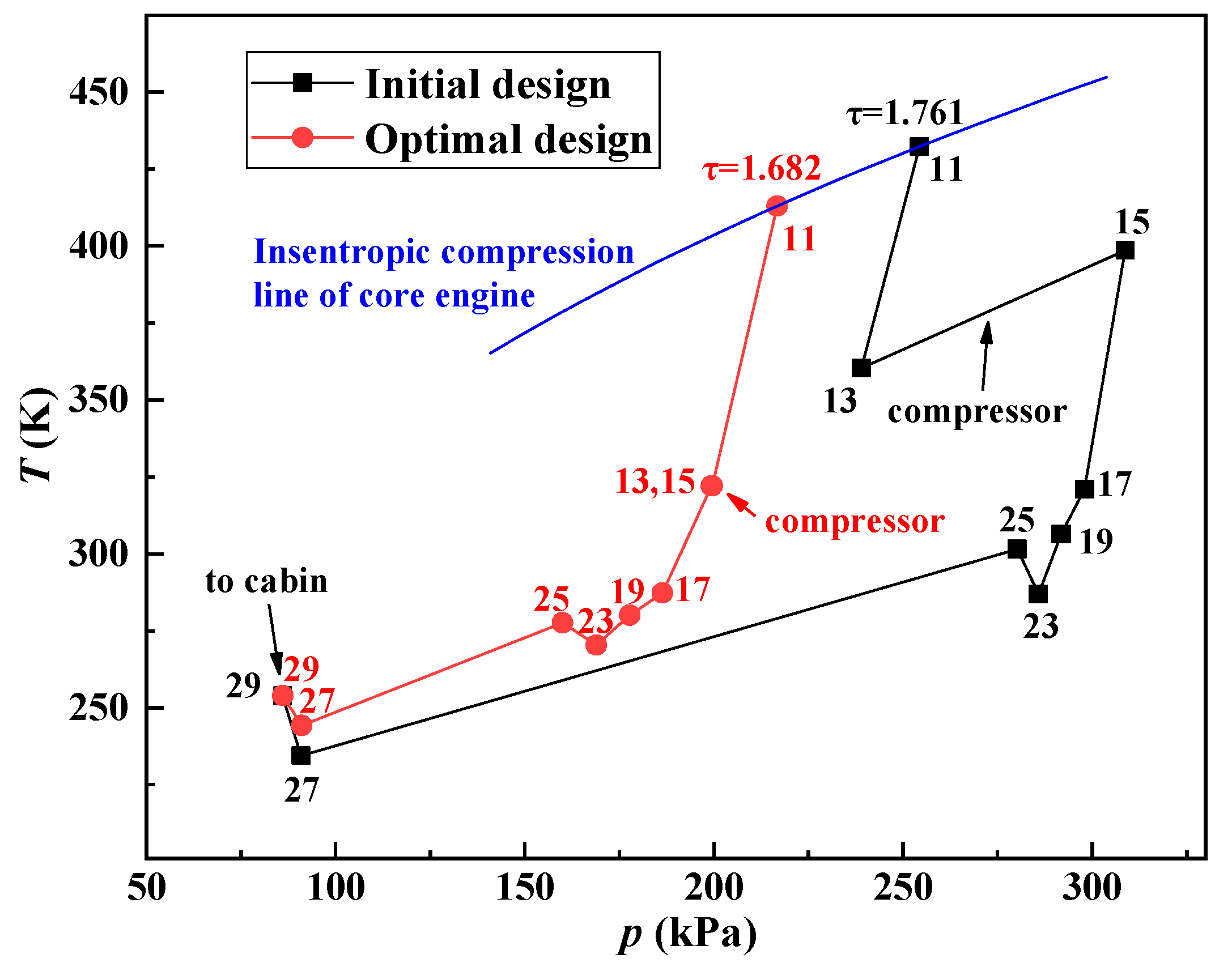
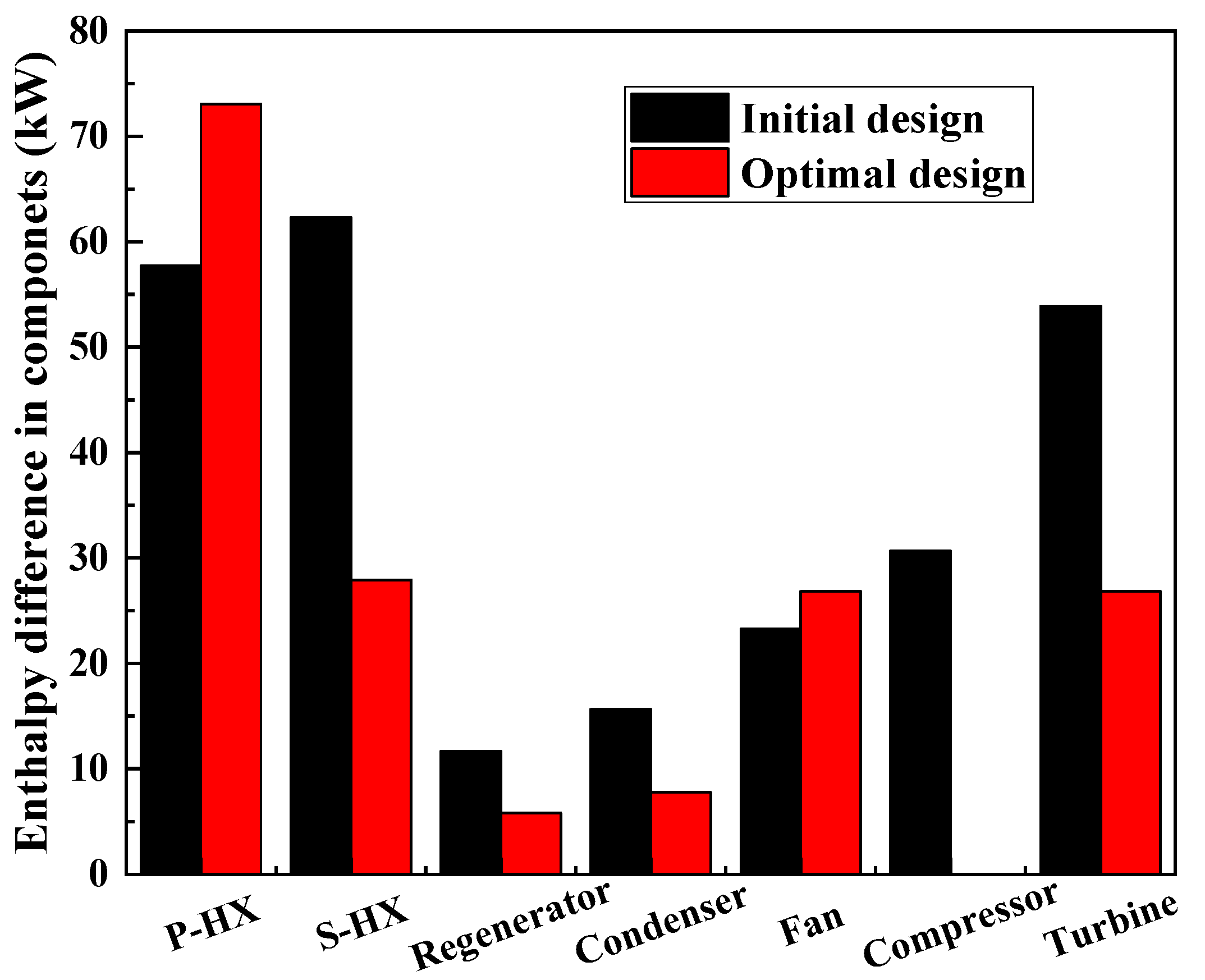
| Node | Ref. [21] | Present Paper | Difference (%) | |||
|---|---|---|---|---|---|---|
| T [K] | p [kPa] | T [K] | p [kPa] | ΔT | Δp | |
| 11 | 485 | 210 | 485 | 210 | 0.00 | 0.00 |
| 13 | 375.8 | 205 | 372.8 | 205 | −0.80 | 0.00 |
| 15 | 437.4 | 307.5 | 433.8 | 307.1 | −0.82 | −0.13 |
| 17 | 295.1 | 303.5 | 292.6 | 303.9 | −0.85 | 0.13 |
| 19 | 265.9 | 299.7 | 260.9 | 299.3 | −1.88 | −0.13 |
| 21 | 242 | 296.2 | 239.6 | 296.1 | −0.99 | −0.03 |
| 25 | 271.1 | 290.2 | 271.3 | 289.4 | 0.07 | −0.28 |
| 27 | 209.9 | 90.7 | 210.0 | 90.4 | 0.05 | −0.33 |
| 29 | 233.5 | 88.2 | 231.2 | 88.4 | −0.99 | 0.23 |
| Flight conditions: | |||
| flight height | 11 km | Mach number | 0.82 |
| Adiabatic efficiencies: | |||
| ECS turbine | 0.809 | ECS compressor | 0.72 |
| ram air diffuser | 0.95 | ram air nozzle | 0.9 |
| Air: | |||
| ram air temperature | 245.6 K | ram air pressure | 35.148 kPa |
| ram air flow rate | 1.45 kg/s | bleed air flow rate | 0.8 kg/s |
| Area of heat exchangers: | |||
| primary heat exchanger | 2 m2 | secondary heat exchanger | 2 m2 |
| Constant outputs: | |||
| ECS cooling capacity | 33 kW | ECS outlet pressure | 86 kPa |
| average exhaust temperature | 295 K | ||
| Fuel energy consumption rate: | 344.79 kW | ||
| A1 | 2 m2~4 m2 | mram | 0.9 kg/s~1.45 kg/s |
| A2 | 2 m2~4 m2 | τ | 1.6~1.78 |
| πc, πt, πf | ≥1 |
| Mutation Type | Binary String | Decimal Value | Mutated Binary Result | Mutated Decimal Value |
|---|---|---|---|---|
| standard GA | 00111110 | 0.2422 | 01111110 | 0.4922 |
| modified GA | 00111110 | 0.2422 | 01000010 | 0.2578 |
| Chromosome | a 32-bit binary gene sequence with 4 variables involved |
| Initial values | four random individuals |
| Selection operator | |
| Crossover operator | multipoint crossing, 4 points for each individual (1 point for each variable, generated in equal probability) |
| Mutation operator | mutation probability: pm = 0.05 |
| Improvements | continuity improvement in mutation operator |
| Parameter | A1 [m2] | A2 [m2] | τ | mram [kg/s] | FECR [kW] | Cost Saved |
|---|---|---|---|---|---|---|
| Initial configuration | 2 | 2 | 1.761 | 1.45 | 344.79 | \ |
| The 1st optimization case | 3.469 | 2.055 | 1.694 | 1.134 | 307.39 | 10.8% |
| The 2nd optimization case | 3.992 | 2.008 | 1.682 | 1.089 | 306.97 | 11.0% |
Publisher’s Note: MDPI stays neutral with regard to jurisdictional claims in published maps and institutional affiliations. |
© 2022 by the authors. Licensee MDPI, Basel, Switzerland. This article is an open access article distributed under the terms and conditions of the Creative Commons Attribution (CC BY) license (https://creativecommons.org/licenses/by/4.0/).
Share and Cite
Liu, Q.; Zhuang, L.; Wen, J.; Dong, B.; Liu, Z. Thermodynamic Optimization of Aircraft Environmental Control System Using Modified Genetic Algorithm. Processes 2022, 10, 721. https://doi.org/10.3390/pr10040721
Liu Q, Zhuang L, Wen J, Dong B, Liu Z. Thermodynamic Optimization of Aircraft Environmental Control System Using Modified Genetic Algorithm. Processes. 2022; 10(4):721. https://doi.org/10.3390/pr10040721
Chicago/Turabian StyleLiu, Qihang, Laihe Zhuang, Jie Wen, Bensi Dong, and Zhiwei Liu. 2022. "Thermodynamic Optimization of Aircraft Environmental Control System Using Modified Genetic Algorithm" Processes 10, no. 4: 721. https://doi.org/10.3390/pr10040721






